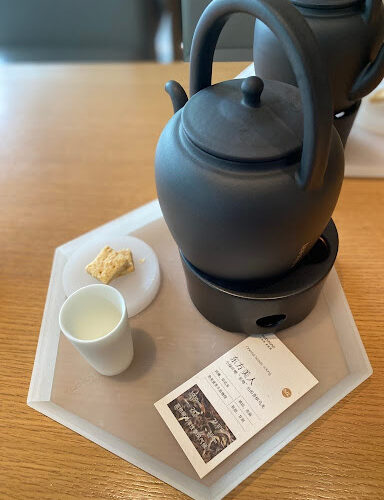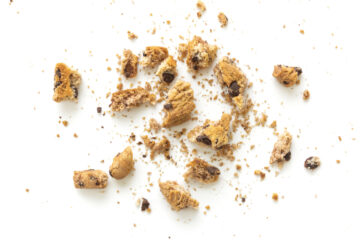Anna Song Photo
By Anna Song
This past summer, I returned to China and encountered a type of tea house called “Xin Zhong Shi (新中式),” which literally translates to “New Chinese Style.” I landed in Shanghai, a city that embodies a richer coffee culture rather than tea culture. However, there are also a decent amount of “New Chinese Style” tea houses in Shanghai. In this article, I present two case studies of “New Chinese Style” tea houses in Shanghai and analyze their similarities and differences.
KAIJI: A Café That Sells Tea
Before visiting the physical site, I followed KAIJI on their official account through WeChat, the main social media platform in China. On its official account, their introduction article indicates that KAI (开) refers to start and open while JI (吉) means luck and fortune. KAIJI connects its brand with the concept of “when young people encounter tea houses” and defines itself as a “tea house for young people (青年茶馆),” that provides a space and opportunity for young people to know more about tea. They follow three main principles:
Inheritance of tradition: Respect tea and Eastern culture
Emergence of modern culture: Merge the young generation’s diverse culture
Explore the future: Continue to push the boundaries of cultural conversations
In Shanghai, there are currently two KAIJI locations, one in Huangpu district and another in a shopping area near Jing’an Temple. My mother and I visited the second location on a Thursday afternoon. Although it was around 4:00 p.m., the tea house was full and we struggled to find a place to sit. The interior includes a bit of Chinese style design such as bamboo chairs and gray concrete walls. There were mostly young people whose average age seemed about 25 to 30 years old and people came in groups of three to five, usually seated to chat about life or work. When I was wandering around, I saw that they had loose tea packed in boxes, tea sets, and some merchandise for sale.
I ordered a bottle of cold brew tea which was obtained in a bottle that looked like a beer bottle (Fig. 1). It’s called “Coconut Sticky Rice Cold Brew,” which is a mix of coconut water and supposedly Pu’er tea that has a tasting profile of sticky rice. I asked those at the bar about the process of making the cold brew. The typical method of cold brew is mixing room temperature water and loose tea and placing the container in the fridge for several hours, usually more than 4 hours. Other than that, their cold brew tea is made by freezing the hot tea liquor immediately after the brewing. Since they also serve hot brewed tea, the bar also has tea pots, which are constantly heated, boiling white tea in order to serve hot tea liquor.
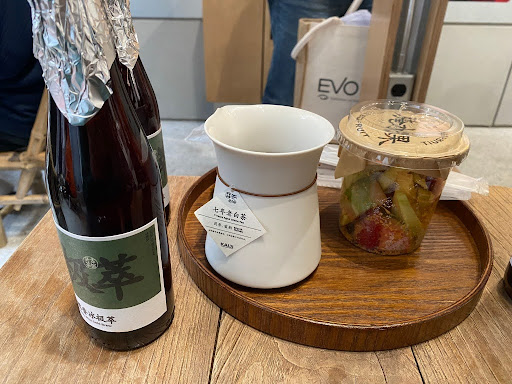
Fig. 1: Cold brew (left), hot brewed white tea (middle), and fruits (right)
Aside from tea, KAIJI also has alcoholic drinks that contain tea liquor and different types of traditional bites. The general price range seems a bit high for me, but it is at about the same level as Starbucks in China.
Sitting in KAIJI, I did not sense any difference between this place and a café. I would also say that some Third Wave coffee shops have more stylistic interior designs than KAIJI. While KAIJI promotes its tea, their purpose seems to be attracting young people with a beverage that is rather novel in such a coffee-dominated city. Most of the customers in KAIJI are drinking the cold brew teas, which are quite different from traditional Chinese tea. That is not to say that I did not appreciate the tea in KAIJI. In fact, I liked the cold brew and the combination with coconut water: it diversified the taste of tea liquor and added freshness to it. However, I did not recognize any connections between traditional Chinese tea and this “tea house.” Traditional Chinese tea’s emphasis on the brewing experience, the interaction with the tea leaves, and the conversation that forms around the tea table are not retained in this “tea house.” It seems that tea is the means to an end, which is to attract young customers.
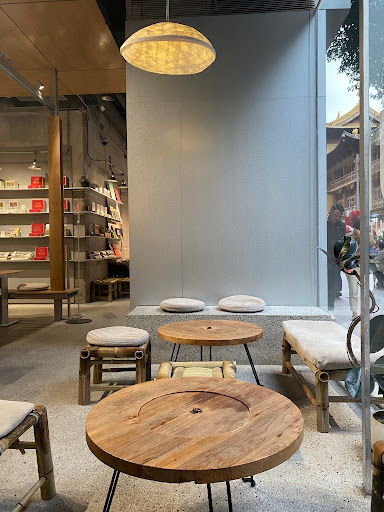
tea’stone: Respecting the Tradition of the Tea Spirit
The day after visiting KAIJI, we visited another famous “New Chinese Style” tea house called tea’stone. The brand originated in Shenzhen and currently only has one tea house in Shanghai. On its official account, they displayed their respect of traditional Chinese tea culture through strictly controlling the quality of their product. In an article titled “Why Tea From tea’stone,” it says:
The professional tasting team which is composed of experienced tea drinkers evaluates each tea for 9 aspects: appearance, color of brew, flavor, cleanness, aroma, sweetness, bitterness, promotion of saliva, and body. Only those that reach over 80% agreement of the professional tasting team could possibly appear in the tea list.
They treat the evaluation of tea with expertise and rigor, which expresses their attitude toward their product. Indeed, their effort showed through the encounter of my taste buds and the tea molecules.
When I stepped into the tea house on a Friday, it was a little bit past 10:00 a.m., their opening hour. The interior was quite modern and resembles a large-scale coffee shop like Starbucks. It was quite empty with basically no customers. Those working in the tea house were busy preparing the hot pots to boil the tea and starting the machine that makes the cold brew. I ordered a pot of hot brewed Oolong tea and my mother ordered a pot of “red tea” (which is usually addressed as “black tea”). The tea came in a large black pot warmed with a candle below (Fig. 2). Each type of tea has a different shaped tea cup that the consumer could drink with. Mine was tall and thin and my mother’s had a wider opening. Accompanied with two small pieces of biscuit which prevents potential low sugar symptoms in customers. There is also an information card on the tray, stating the climate, humidity, altitude, average temperature, and precipitation of the manufacturer of this tea. The card also includes some short descriptions and tasting notes of the tea. This is quite helpful for those that are unfamiliar with tea and is a good method to spread tea knowledge.
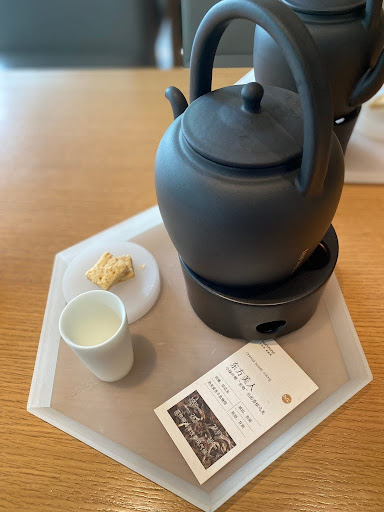
Fig. 2: Oolong tea, warmed with candle, along with tea cup and biscuits
The tea shop also has a section designated for their own products which includes loose tea, tea gift boxes, tea ware, etc. Their tea bags are designed according to different types of tea: green bags contain green tea; white bags hold white tea (Fig 3); etc. The glass cones (Fig. 4) allow the customers to observe the form of the dry leaves and sense the aroma of it. I briefly chatted with the young man at the counter and he informed me that people of all age groups visit the tea house and they usually come to work or talk with friends. I also asked him about their loose tea and tea gift boxes. He said that the gift boxes are quite popular amongst young people, especially before holidays. This shows that although young people are exposed to a larger variety of drinks, the tradition of tea as gifts still continues to the younger generation.
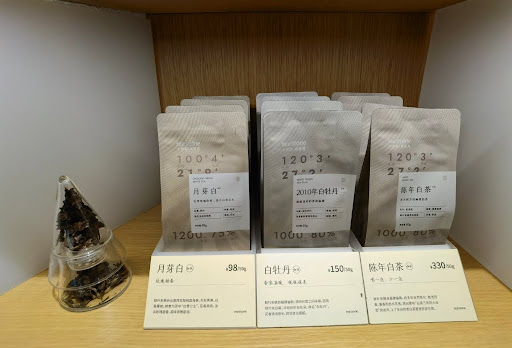
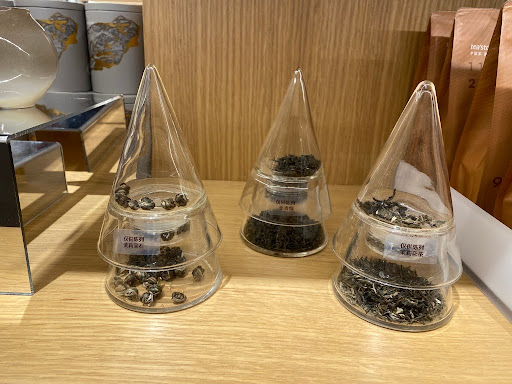
Fig. 4: Glass cones for aroma
I saw a post on a Chinese social media platform commenting that tea’stone is similar to Starbucks. I would disagree because tea’stone provides various information about tea types, tea processing, and tea brewing which Starbucks does not have for coffee. tea’stone provides a good platform for those interested in tea to learn a bit more of what they drink. It could be a better bridge between traditional Chinese tea culture and the younger generation.
Can They Co-Exist: The Modern Society and The Traditional Tea
KAIJI and tea’stone are showcasing different types of “New Chinese Style” tea houses that exist in the market. In my opinion, tea’stone provides more educational information of tea and could potentially attract more young people to appreciate tea. However, it did not represent two aspects of tea spirit that I value the most. Firstly, the spirit of sharing is not present in KAIJI or tea’stone. Traditionally, brewed tea is shared amongst a group of people: family or friends. A tea set also comes with one teapot and multiple tea cups, which is meant for a shared experience. The drinks in KAIJI and tea’stone, however, are designed for one customer instead of a group of customers. I understand that this would be more friendly for the customers that enter the tea house alone, but providing the option of sharing tea amongst a group of customers could be a better representation of traditional Chinese tea culture. Secondly, the spirit of enjoying the present moment and the environment is not included in the design of the two tea houses. The essence is to “slow down” and be present. More traditional tea houses are usually in quiet places whereas both KAIJI and tea’stone sit in the commercial center of the city. However, being in the center attracts more attention and thus customers and this is a strategy widely utilized by restaurants or cafés in Shanghai. I even wonder: Do people simply want to find a place to talk or work, no matter whether it serves coffee or tea? Could people actually understand the essence of tea when drinking in these tea houses? Can this fast-paced society co-exist with the slowness of tea?
The “New Chinese Style” tea house is not as attractive as the popular milk tea, bubble tea, and fruit tea, which have more versatile flavors. It is also not as energizing as different types of coffee drinks, such as americano and latte. For those that are not drinkers of traditional Chinese tea, “New Chinese Style” tea house might be a one-time visit. However, for experienced tea-drinkers, the most important aspects of tea spirit are not represented in these tea houses. “New Chinese Style” tea houses thus stand in an awkward position. I still question whether “New Chinese Style” tea houses could cause more people to appreciate tea and its spirit, but admittedly, it might attract the attention of those that already have some interest in tea.

